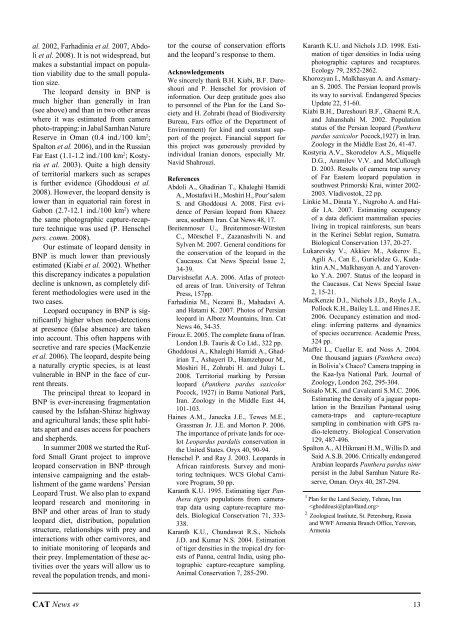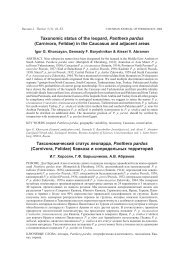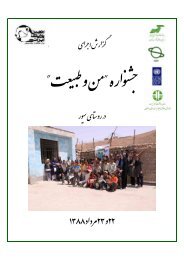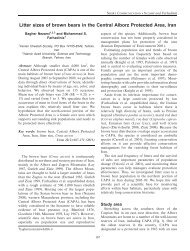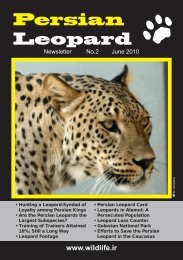The Status of the Persian Leopard in Bamu National Park, Iran
The Status of the Persian Leopard in Bamu National Park, Iran
The Status of the Persian Leopard in Bamu National Park, Iran
Create successful ePaper yourself
Turn your PDF publications into a flip-book with our unique Google optimized e-Paper software.
al. 2002, Farhad<strong>in</strong>ia et al. 2007, Abdoli<br />
et al. 2008). It is not widespread, but<br />
makes a substantial impact on population<br />
viability due to <strong>the</strong> small population<br />
size.<br />
<strong>The</strong> leopard density <strong>in</strong> BNP is<br />
much higher than generally <strong>in</strong> <strong>Iran</strong><br />
(see above) and than <strong>in</strong> two o<strong>the</strong>r areas<br />
where it was estimated from camera<br />
photo-trapp<strong>in</strong>g: <strong>in</strong> Jabal Samhan Nature<br />
Reserve <strong>in</strong> Oman (0.4 <strong>in</strong>d./100 km 2 ;<br />
Spalton et al. 2006), and <strong>in</strong> <strong>the</strong> Russian<br />
Far East (1.1-1.2 <strong>in</strong>d./100 km 2 ; Kostyria<br />
et al. 2003). Quite a high density<br />
<strong>of</strong> territorial markers such as scrapes<br />
is fur<strong>the</strong>r evidence (Ghoddousi et al.<br />
2008). However, <strong>the</strong> leopard density is<br />
lower than <strong>in</strong> equatorial ra<strong>in</strong> forest <strong>in</strong><br />
Gabon (2.7-12.1 <strong>in</strong>d./100 km 2 ) where<br />
<strong>the</strong> same photographic capture-recapture<br />
technique was used (P. Henschel<br />
pers. comm. 2008).<br />
Our estimate <strong>of</strong> leopard density <strong>in</strong><br />
BNP is much lower than previously<br />
estimated (Kiabi et al. 2002). Whe<strong>the</strong>r<br />
this discrepancy <strong>in</strong>dicates a population<br />
decl<strong>in</strong>e is unknown, as completely different<br />
methodologies were used <strong>in</strong> <strong>the</strong><br />
two cases.<br />
<strong>Leopard</strong> occupancy <strong>in</strong> BNP is significantly<br />
higher when non-detections<br />
at presence (false absence) are taken<br />
<strong>in</strong>to account. This <strong>of</strong>ten happens with<br />
secretive and rare species (MacKenzie<br />
et al. 2006). <strong>The</strong> leopard, despite be<strong>in</strong>g<br />
a naturally cryptic species, is at least<br />
vulnerable <strong>in</strong> BNP <strong>in</strong> <strong>the</strong> face <strong>of</strong> current<br />
threats.<br />
<strong>The</strong> pr<strong>in</strong>cipal threat to leopard <strong>in</strong><br />
BNP is ever-<strong>in</strong>creas<strong>in</strong>g fragmentation<br />
caused by <strong>the</strong> Isfahan-Shiraz highway<br />
and agricultural lands; <strong>the</strong>se split habitats<br />
apart and eases access for poachers<br />
and shepherds.<br />
In summer 2008 we started <strong>the</strong> Rufford<br />
Small Grant project to improve<br />
leopard conservation <strong>in</strong> BNP through<br />
<strong>in</strong>tensive campaign<strong>in</strong>g and <strong>the</strong> establishment<br />
<strong>of</strong> <strong>the</strong> game wardens’ <strong>Persian</strong><br />
<strong>Leopard</strong> Trust. We also plan to expand<br />
leopard research and monitor<strong>in</strong>g <strong>in</strong><br />
BNP and o<strong>the</strong>r areas <strong>of</strong> <strong>Iran</strong> to study<br />
leopard diet, distribution, population<br />
structure, relationships with prey and<br />
<strong>in</strong>teractions with o<strong>the</strong>r carnivores, and<br />
to <strong>in</strong>itiate monitor<strong>in</strong>g <strong>of</strong> leopards and<br />
<strong>the</strong>ir prey. Implementation <strong>of</strong> <strong>the</strong>se activities<br />
over <strong>the</strong> years will allow us to<br />
reveal <strong>the</strong> population trends, and monitor<br />
<strong>the</strong> course <strong>of</strong> conservation efforts<br />
and <strong>the</strong> leopard’s response to <strong>the</strong>m.<br />
Acknowledgements<br />
We s<strong>in</strong>cerely thank B.H. Kiabi, B.F. Dareshouri<br />
and P. Henschel for provision <strong>of</strong><br />
<strong>in</strong>formation. Our deep gratitude goes also<br />
to personnel <strong>of</strong> <strong>the</strong> Plan for <strong>the</strong> Land Society<br />
and H. Zohrabi (head <strong>of</strong> Biodiversity<br />
Bureau, Fars <strong>of</strong>fice <strong>of</strong> <strong>the</strong> Department <strong>of</strong><br />
Environment) for k<strong>in</strong>d and constant support<br />
<strong>of</strong> <strong>the</strong> project. F<strong>in</strong>ancial support for<br />
this project was generously provided by<br />
<strong>in</strong>dividual <strong>Iran</strong>ian donors, especially Mr.<br />
Navid Shahrouzi.<br />
References<br />
Abdoli A., Ghadirian T., Khaleghi Hamidi<br />
A., Mostafavi H., Moshiri H., Pour’salem<br />
S. and Ghoddousi A. 2008. First evidence<br />
<strong>of</strong> <strong>Persian</strong> leopard from Khaeez<br />
area, sou<strong>the</strong>rn <strong>Iran</strong>. Cat News 48, 17.<br />
Breitenmoser U., Breitenmoser-Würsten<br />
C., Mörschel F., Zazanashvili N. and<br />
Sylven M. 2007. General conditions for<br />
<strong>the</strong> conservation <strong>of</strong> <strong>the</strong> leopard <strong>in</strong> <strong>the</strong><br />
Caucasus. Cat News Special Issue 2,<br />
34-39.<br />
Darvishsefat A.A. 2006. Atlas <strong>of</strong> protected<br />
areas <strong>of</strong> <strong>Iran</strong>. University <strong>of</strong> Tehran<br />
Press, 157pp.<br />
Farhad<strong>in</strong>ia M., Nezami B., Mahadavi A.<br />
and Hatami K. 2007. Photos <strong>of</strong> <strong>Persian</strong><br />
leopard <strong>in</strong> Alborz Mounta<strong>in</strong>s, <strong>Iran</strong>. Cat<br />
News 46, 34-35.<br />
Firouz E. 2005. <strong>The</strong> complete fauna <strong>of</strong> <strong>Iran</strong>.<br />
London I.B. Tauris & Co Ltd., 322 pp.<br />
Ghoddousi A., Khaleghi Hamidi A., Ghadirian<br />
T., Ashayeri D., Hamzehpour M.,<br />
Moshiri H., Zohrabi H. and Julayi L.<br />
2008. Territorial mark<strong>in</strong>g by <strong>Persian</strong><br />
leopard (Pan<strong>the</strong>ra pardus saxicolor<br />
Pocock, 1927) <strong>in</strong> <strong>Bamu</strong> <strong>National</strong> <strong>Park</strong>,<br />
<strong>Iran</strong>. Zoology <strong>in</strong> <strong>the</strong> Middle East 44,<br />
101-103.<br />
Ha<strong>in</strong>es A.M., Janecka J.E., Tewes M.E.,<br />
Grassman Jr. J.E. and Morton P. 2006.<br />
<strong>The</strong> importance <strong>of</strong> private lands for ocelot<br />
<strong>Leopard</strong>us pardalis conservation <strong>in</strong><br />
<strong>the</strong> United States. Oryx 40, 90-94.<br />
Henschel P. and Ray J. 2003. <strong>Leopard</strong>s <strong>in</strong><br />
African ra<strong>in</strong>forests. Survey and monitor<strong>in</strong>g<br />
techniques. WCS Global Carnivore<br />
Program, 50 pp.<br />
Karanth K.U. 1995. Estimat<strong>in</strong>g tiger Pan<strong>the</strong>ra<br />
tigris populations from cameratrap<br />
data us<strong>in</strong>g capture-recapture models.<br />
Biological Conservation 71, 333-<br />
338.<br />
Karanth K.U., Chundawat R.S., Nichols<br />
J.D. and Kumar N.S. 2004. Estimation<br />
<strong>of</strong> tiger densities <strong>in</strong> <strong>the</strong> tropical dry forests<br />
<strong>of</strong> Panna, central India, us<strong>in</strong>g photographic<br />
capture-recapture sampl<strong>in</strong>g.<br />
Animal Conservation 7, 285-290.<br />
Karanth K.U. and Nichols J.D. 1998. Estimation<br />
<strong>of</strong> tiger densities <strong>in</strong> India us<strong>in</strong>g<br />
photographic captures and recaptures.<br />
Ecology 79, 2852-2862.<br />
Khorozyan I., Malkhasyan A. and Asmaryan<br />
S. 2005. <strong>The</strong> <strong>Persian</strong> leopard prowls<br />
its way to survival. Endangered Species<br />
Update 22, 51-60.<br />
Kiabi B.H., Dareshouri B.F., Ghaemi R.A.<br />
and Jahanshahi M. 2002. Population<br />
status <strong>of</strong> <strong>the</strong> <strong>Persian</strong> leopard (Pan<strong>the</strong>ra<br />
pardus saxicolor Pocock,1927) <strong>in</strong> <strong>Iran</strong>.<br />
Zoology <strong>in</strong> <strong>the</strong> Middle East 26, 41-47.<br />
Kostyria A.V., Skorodelov A.S., Miquelle<br />
D.G., Aramilev V.V. and McCullough<br />
D. 2003. Results <strong>of</strong> camera trap survey<br />
<strong>of</strong> Far Eastern leopard population <strong>in</strong><br />
southwest Primorski Krai, w<strong>in</strong>ter 2002-<br />
2003. Vladivostok, 22 pp.<br />
L<strong>in</strong>kie M., D<strong>in</strong>ata Y., Nugroho A. and Haidir<br />
I.A. 2007. Estimat<strong>in</strong>g occupancy<br />
<strong>of</strong> a data deficient mammalian species<br />
liv<strong>in</strong>g <strong>in</strong> tropical ra<strong>in</strong>forests, sun bears<br />
<strong>in</strong> <strong>the</strong> Ker<strong>in</strong>ci Seblat region, Sumatra.<br />
Biological Conservation 137, 20-27.<br />
Lukarevsky V., Akkiev M., Askerov E.,<br />
Agili A., Can E., Gurielidze G., Kudakt<strong>in</strong><br />
A.N., Malkhasyan A. and Yarovenko<br />
Y.A. 2007. <strong>Status</strong> <strong>of</strong> <strong>the</strong> leopard <strong>in</strong><br />
<strong>the</strong> Caucasus. Cat News Special Issue<br />
2, 15-21.<br />
MacKenzie D.I., Nichols J.D., Royle J.A.,<br />
Pollock K.H., Bailey L.L. and H<strong>in</strong>es J.E.<br />
2006. Occupancy estimation and model<strong>in</strong>g:<br />
<strong>in</strong>ferr<strong>in</strong>g patterns and dynamics<br />
<strong>of</strong> species occurrence. Academic Press,<br />
324 pp.<br />
Maffei L., Cuellar E. and Noss A. 2004.<br />
One thousand jaguars (Pan<strong>the</strong>ra onca)<br />
<strong>in</strong> Bolivia’s Chaco? Camera trapp<strong>in</strong>g <strong>in</strong><br />
<strong>the</strong> Kaa-Iya <strong>National</strong> <strong>Park</strong>. Journal <strong>of</strong><br />
Zoology, London 262, 295-304.<br />
Soisalo M.K. and Cavalcanti S.M.C. 2006.<br />
Estimat<strong>in</strong>g <strong>the</strong> density <strong>of</strong> a jaguar population<br />
<strong>in</strong> <strong>the</strong> Brazilian Pantanal us<strong>in</strong>g<br />
camera-traps and capture-recapture<br />
sampl<strong>in</strong>g <strong>in</strong> comb<strong>in</strong>ation with GPS radio-telemetry.<br />
Biological Conservation<br />
129, 487-496.<br />
Spalton A., Al Hikmani H.M., Willis D. and<br />
Said A.S.B. 2006. Critically endangered<br />
Arabian leopards Pan<strong>the</strong>ra pardus nimr<br />
persist <strong>in</strong> <strong>the</strong> Jabal Samhan Nature Reserve,<br />
Oman. Oryx 40, 287-294.<br />
1 Plan for <strong>the</strong> Land Society, Tehran, <strong>Iran</strong><br />
<br />
2 Zoological Institute, St. Petersburg, Russia<br />
and WWF Armenia Branch Office, Yerevan,<br />
Armenia<br />
CAT News 49 13


